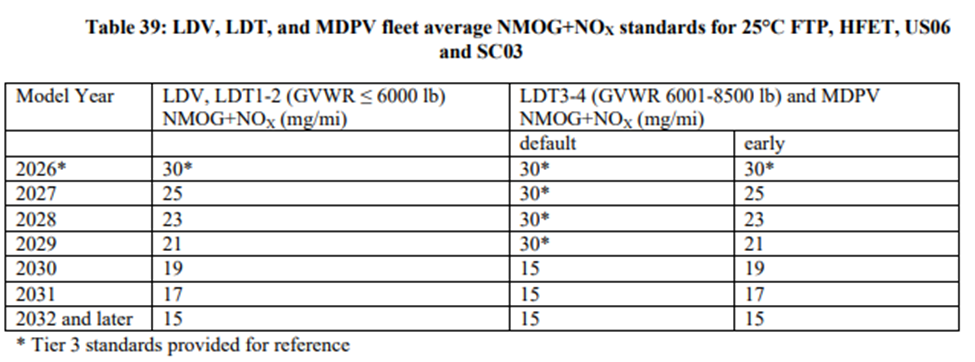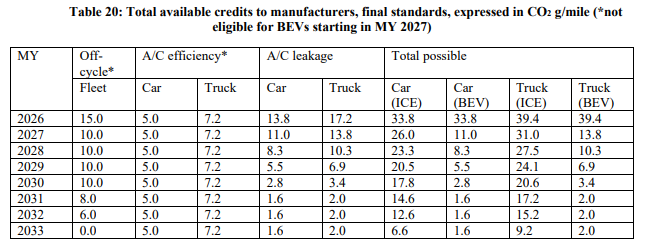Overview of EPA MY2027-2032 GHG and criteria pollutant emission standards
GHG Standards
The final light-duty standards would reduce the fleet average GHG emissions target levels by 50% from the MY2026 standards. EPA finalized separate passenger car and light truck standards. Specifically, EPA finalized a more stringent final fleet-wide CO2 emissions standard that is projected to result in an industry-wide average target of 85 g/mile of CO2 in MY2032. EPA based the final standards, in part, on the proposed rule’s Alternative 3. Although the final standard is more stringent than proposed standard, the steepest emissions reductions will be during the last few years of the regulatory period, affording industry additional time to comply.

See Table 1, Final Rule
Criteria and Toxic Pollutant Emission Standards
EPA finalized the following emissions standards, with multiple phase in scenarios and early compliance options:
- Nonmethane organic gases (“NMOG”) plus nitrogen oxides (“NOx”): EPA finalized standards that would phase-down to a fleet average level of 15 gm/mi NMOG + NOx by MY2032 (50% reduction from MY2025)

See Table 39, Final Rule
- Particulate matter (PM): 0.5 mg/mi cap (per vehicle) and requirement to meet standard across three test cycles (including a cold temperature test)
- Carbon monoxide (CO): The CO caps are 1.7 g/mile in the 25°C FTP, HFET, and SC03 test cycles, 9.6 g/mile in the US06 (increased from 1.7 g/mile as proposed), and 10.0 g/mile in the -7°C FTP
- Formaldehyde (HCHO): HCHO cap is 4 mg/mile in the 25°C FTP
Changes to Flexibilities and Incentives
The final rule retains some of the current compliance incentives and flexibilities, including the Credit Averaging, Banking, and Trading (ABT) program. EPA finalized significant changes/phase-outs, however, to several other flexibilities:
- Air Conditioning (“A/C”) Efficiency Credits:
- Phase-down of A/C refrigerant-based credits from MY2027-2030. For MY2031 and later, EPA is retaining small A/C refrigerant credits
- Limit A/C efficiency credit eligibility beginning in MY2027 to vehicles with internal combustion engines (ICE) only
- Off-Cycle Credit Program: Sunset the off-cycle credit program for light- and medium-duty vehicles by:
- Phasing out menu-based credits by reducing the menu credit cap year-over-year until it is fully phased out in MY2033 by setting a declining menu cap of 10/8/6/0 grams per mile (g/mile) for non-battery electric vehicles (BEVs) over MY2030-2033
- Eliminating the 5-cycle and public process pathways starting in MY2027
- Limiting eligibility for off-cycle credits to only vehicles with tailpipe emissions greater than zero (i.e., ICE vehicles)
- EPA is removing the BEV, PHEV, and fuel cell EV (FCEV) multipliers starting MY2027.
- Under the GHG program, for MY2027 and later, BEVs and FCEVs would be counted as 0 g/mile and PHEVs would apply the 0 g/mile factor to electric-only vehicle operation for compliance calculations.

See Table 20, Final Rule
BEV/PHEV Battery Durability and Warranty Requirements
The final rule generally adopts as proposed the battery durability monitoring and performance requirements for light-duty BEVs and PHEVs, and battery durability monitoring requirements for Class 2b and 3 BEVs and PHEVs, beginning with MY2027. In finalizing the battery durability provisions, EPA states that the “final rule continues [its] longstanding policy of ensuring durability for emissions control components and builds upon the existing durability requirements for batteries.” EPA acknowledged that some commentors urged EPA to align with CARB to avoid conflicting requirements for each agency’s durability program under Advanced Clean Cars (ACC) II. While EPA maintains it is possible for manufacturers to comply with both durability programs, EPA will accept manufacturer compliance with the entirety of the ACC II durability program in lieu of the EPA durability program. Manufacturers must state their intention to take advantage of this optional pathway, “in which case their compliance with the CARB durability program will be deemed as compliance with the EPA durability program.”
EPA finalized its proposal for light-duty and Class 2b and 3 BEVs and PHEVs to be required to include a customer-readable battery state-of-health (SOH) monitor that reports the vehicle’s state of certified energy (SOCE). Light-duty BEVs and PHEVs will also be subject to a minimum performance requirement (MPR) for the SOH, as follows:

See Table 65, Final Rule
Battery and Vehicle Component Warranty
Importantly, the final rule defines BEV and PHEV batteries and associated electronic powertrain components as specified major emission control components, subject to a warranty period of 8 years or 80,000 miles. For medium-duty (Class 2b and 3) BEVs and PHEVs, the final rule establishes a warranty period of 8 years or 80,000 miles for the battery and associated electric powertrain components on such vehicles. EPA declined to tie the battery warranty performance criteria to the durability performance requirement, at this time.
In addition, EPA is revising the durability group definition for vehicles with an ICE engine, and adding two new grouping definitions, monitor family and battery durability family, for BEVs and PHEVs.
Emissions Warranty for Certain ICE Components
EPA finalized its proposal to designate several emission control components and systems of light-duty ICE vehicles as specified major emission control components (subject to 8 years or 80,000 miles for warranty coverage), including: components of the diesel Selective Reductant Catalysts (SRC) system, components of the diesel Exhaust Gas Recirculation (EGR) system, and diesel and gasoline particulate filters (DPFs and GPFs).
The final rule also addresses changes to the certification compliance and enforcement requirements for GHG exhaust emission standards, certification application requirements and clarifies AECD disclosure requirements, OBD diagnostics program updates, and more.
Additional information about the Multi-Pollutant rule is available on EPA’s website. The rule will be effective June 17, 2024. Legal challenges to the rule must also be filed by June 17, 2024.
DOE PEF Final Rule
On March 19, 2024, the Department of Energy (DOE) issued a final rule revising both the petroleum-equivalency factor (PEF) and the procedures for calculating the petroleum-equivalent fuel economy of electric vehicles (EVs) beginning in model year (MY) 2027. See DOE, Final Rule, Petroleum-Equivalent Fuel Economy Calculation. The new PEF will be phased in over time from a PEF of 79,989 in MY2027 to a PEF of 28,996 in MY2030 and later. The final PEF value at the end of the phase in period (MY2030), depicted below, is higher than the PEF initially proposed in April 2023 (23,160 Watt-hours per gallon).
EPA uses the PEF to calculate light-duty manufacturer’s compliance with the National Highway Traffic Safety Administration (NHTSA) corporate average fuel economy (CAFE) standards. DOE implemented two significant changes in the final rule. First, the final rule changes the method of calculating the PEF value from using an average of annual PEF values between MY2027-2031 to calculating a PEF value based on the survivability-weighted lifetime mileage schedule of the fleet of vehicles sold during the regulatory period. DOE adopted the final PEF values as follows:


See Final Rule, at 49-50
Second, the final rule includes a fuel content factor phase-out between MY2027-2030. In doing so, DOE struck a balance of keeping the fuel content factor for a limited time to provide short-term incentives for EVs, while recognizing that the industry will be adequately incentivized by 2030 and can phase out the fuel content factor. The phase out is depicted as follows:

See Final Rule, at 45
The rule will be effective June 12, 2024.